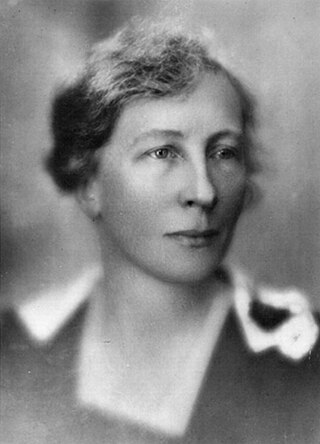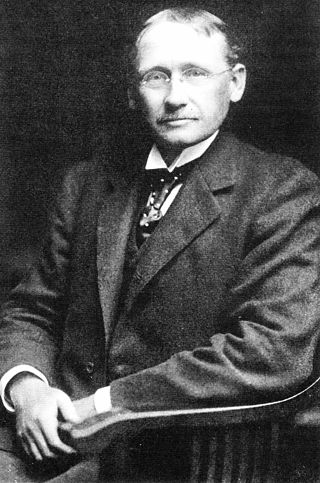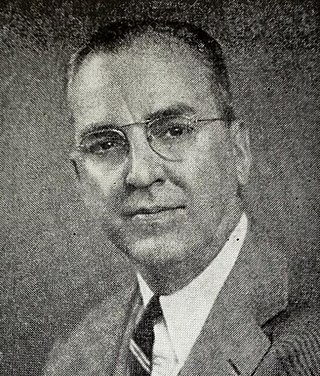Related Research Articles

Lillian Evelyn Gilbreth was an American psychologist, industrial engineer, consultant, and educator who was an early pioneer in applying psychology to time-and-motion studies. She was described in the 1940s as "a genius in the art of living." Gilbreth, one of the first female engineers to earn a Ph.D., is considered to be the first industrial/organizational psychologist. She and her husband, Frank Bunker Gilbreth, were efficiency experts who contributed to the study of industrial engineering, especially in the areas of motion study and human factors. Cheaper by the Dozen (1948) and Belles on Their Toes (1950), written by two of their children tell the story of their family life and describe how time-and-motion studies were applied to the organization and daily activities of their large family. Both books were later made into feature films.

Scientific management is a theory of management that analyzes and synthesizes workflows. Its main objective is improving economic efficiency, especially labor productivity. It was one of the earliest attempts to apply science to the engineering of processes to management. Scientific management is sometimes known as Taylorism after its pioneer, Frederick Winslow Taylor.

Frank Bunker Gilbreth was an American engineer, consultant, and author known as an early advocate of scientific management and a pioneer of time and motion study, and is perhaps best known as the father and central figure of Cheaper by the Dozen.

A time and motion study is a business efficiency technique combining the Time Study work of Frederick Winslow Taylor with the Motion Study work of Frank and Lillian Gilbreth. It is a major part of scientific management (Taylorism). After its first introduction, time study developed in the direction of establishing standard times, while motion study evolved into a technique for improving work methods. The two techniques became integrated and refined into a widely accepted method applicable to the improvement and upgrading of work systems. This integrated approach to work system improvement is known as methods engineering and it is applied today to industrial as well as service organizations, including banks, schools and hospitals.
John Nelson Warfield was an American systems scientist, who was professor and director of the Institute for Advanced Study in the Integrative Sciences (IASIS) at George Mason University, and president of the Systems, Man, and Cybernetics Society.
Paul Ernest Torgersen was the 14th President of Virginia Polytechnic Institute and State University.

Industrial engineering is an engineering profession that is concerned with the optimization of complex processes, systems, or organizations by developing, improving and implementing integrated systems of people, money, knowledge, information and equipment. Industrial engineering is central to manufacturing operations.
Allan Herbert Mogensen, known as Mogy, was an American industrial engineer, and industry consultant, and an authority in the field of work simplification and office management. He is noted for popularizing flowcharts in the 1930s, and is remembered as "father of work simplification"
Benjamin Seaver Blanchard, Jr. was an American systems engineer and Emeritus Professor of Industrial and Systems Engineering at Virginia Tech, who was awarded the INCOSE Pioneer Award jointly with Wolt Fabrycky as "practitioner, teacher, and advocate of Systems Engineering."
John Michael Prausnitz is a professor of chemical engineering at the University of California, Berkeley, a position he has held since 1955.
Gilbreth, Inc. was the early management consulting and industrial engineering firm of Frank Bunker Gilbreth and his wife Lillian Moller Gilbreth. It was founded as Frank B. Gilbreth, Inc., consulting engineers, in 1911. Lillian renamed it Gilbreth, Inc. after Frank's death in 1924.
Laxmangudi Krishnamurthy Doraiswamy (1927–2012) was an Indian-American chemical engineer, author and academic, known for his contributions in developing Organic synthesis engineering as a modern science discipline. Chemical Engineering journal of McGraw Hill listed him among the 10 most distinguished chemical engineers in the world in 1988. He was the author of nine texts in chemical engineering, including Organic Synthesis Engineering, a 2001 publication which is known to have introduced the topic as a definitive scientific stream and Heterogeneous reactions: Analysis, Examples, and Reactor Design, reportedly the first comprehensive text in chemical engineering.

Harold Bright Maynard was an American industrial engineer, consulting engineer at the Methods Engineering Council, and management author. He is known as the "Broadway counsel for industries, railroads, state governments" and as recipient of the Henry Laurence Gantt Medal in 1964.
The Gilbreth Medal is named after Frank Bunker Gilbreth Sr. and Lillian Gilbreth and is presented in recognition of excellence int he field of motion, skill, and fatigue study. Originally awarded in 1931 by the Society of Industrial Engineers the award continues to be presented following the organizations merger in 1936 with The Taylor Society under the new organization, The Society for Advancement of Management.
The Wallace Clark Award or Wallace Clark Medal is a former management award for Distinguished Contribution to Scientific Management, named after Henry Wallace Clark (1880-1948). The Wallace Clark Award was established in 1949 and was sponsored by the American Management Association (AMA), the American Society of Mechanical Engineers (ASME), the Association for Consulting Management Engineers and the Society for the Advancement of Management.

James Keith Louden was an American industrial engineer, business executive, and management author. He served as the 4th president of the Society for Advancement of Management in the year 1941-1942, and was the recipient of the 1949 Gilbreth Medal.
Ralph Currier Davis was an American industrial and consulting engineer, Professor of Business Organization at Ohio State University, and organizational theorist. He is known for his work on top management, especially his 1951 extension of Henri Fayol's work.

Annie "Anne" Gillespie Shaw CBE was a Scottish engineer and businesswoman. Shaw specialised in time and motion studies. In 1945, she founded the Anne Shaw Organisation Ltd, a consulting company.
References
- ↑ J.-C. Spender, Hugo Kijne. Scientific Management: Frederick Winslow Taylor’s Gift to the World? 2012. p. 81
- ↑ March, James G., and Herbert Alexander Simon. Organizations. (1958).
- ↑ Karasek, Robert, and Tores Theorell. Healthy work: stress, productivity, and the reconstruction of working life. Basic books, 1992.
- 1 2 3 4 5 6 Ralph Mosser Barnes at wf-eng.slerahosting.com. Accessed 06-07-2017.